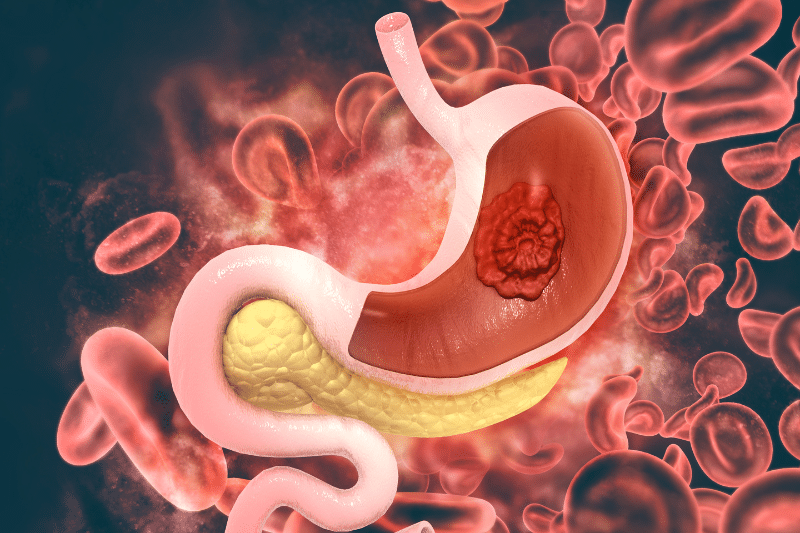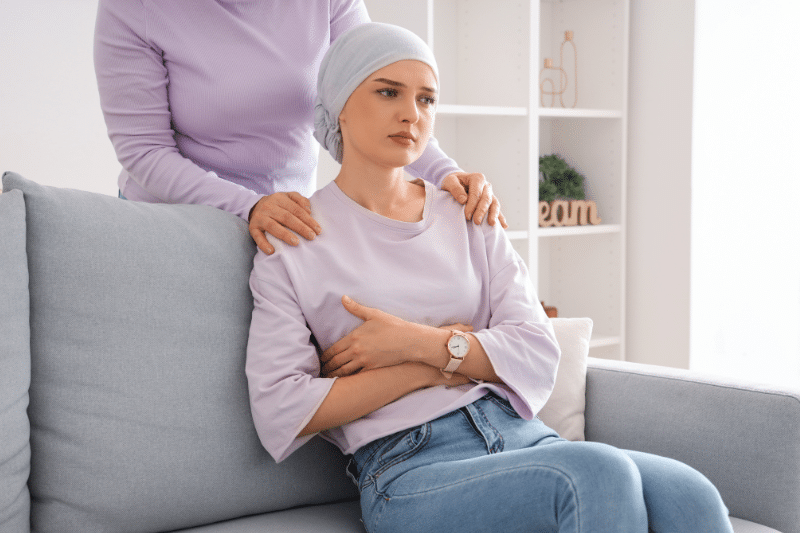Stomach Cancer Signs and Symptoms Overview
Stomach cancer or gastric cancer is a major health concern worldwide. Despite all the advances in medical research and technology, stomach, called gastric cancer is one of the top cancer killers.
According to the NIH report, there were over 1.1 million new cases of stomach cancer in 2020 and over 700,000 deaths.
In the US, stomach cancer is less common than in other parts of the world but still a big deal. The American Cancer Society estimates 27,000 new cases treat stomach cancer alone in 2024 and 11,000 deaths. Therefore, early detection and awareness are crucial for both cancer prevention and improving survival rates. Doctors often diagnose stomach cancer late when treatment options are limited.
Early Detection and Awareness
The survival rate for stomach cancer varies greatly depending on the stage. Early-stage stomach cancer is treatable with a 5-year survival rate of around 70%. Advanced-stage stomach cancer has a 5-year survival rate of about 30%. The difference is huge.
By recognizing the early signs and symptoms of stomach cancer, you can get medical attention sooner and get stomach cancer diagnosed and treated earlier.
What is Stomach Cancer and How it Affects the Body?
Stomach cancer occurs when cancerous cells form in the lining of the stomach. The stomach is part of the digestive system and breaks down food and absorbs nutrients. When cancer develops in this organ it can affect digestion, nutrient absorption, and overall health.
Over time stomach cancer can spread to other parts of the digestive tract and the body like the liver, lungs, and lymph nodes making treatment and prognosis after stomach surgery even more complicated.
What are the Types of Stomach Cancers and Their Frequency?
Stomach cancer is not one disease but a group of stomach cancers, that can occur in different parts of the same to develop stomach cancer cells. The most common is adenocarcinoma which accounts for 90-95% of all stomach cancers. This type of remaining cancer cells starts in the glandular cells of the stomach lining. Other less common types of stomach cancer are:
Gastrointestinal Stromal Tumors (GISTs)
These cancers occur in the interstitial cells of Cajal in the stomach wall.
Neuroendocrine Tumors (NETs)
These tumors start in the hormone-producing cells of the stomach.
Lymphomas
Cancers of the immune system can occur in the stomach’s lymphatic tissue.
The frequency of each cancer specialist type of stomach cancer treatment and of targeted therapy for treating stomach cancer varies but adenocarcinoma is the most common due to its high incidence and late diagnosis.

Who’s at Risk?
Knowing who is at risk for stomach cancer can help with early detection and prevention. Several risk factors contribute to stomach cancer:
Age
Risk increases with age, most cases are diagnosed in people over 60.
Gender
Men are twice as likely to get stomach cancer.
Diet
A diet high in smoked, pickled, and salty foods increases the risk of stomach cancer. A healthy diet, rich in fruits and vegetables may lower the risk.
Genetics
A family history of stomach cancer increases risk, as does certain genetic conditions like Lynch syndrome and hereditary diffuse gastric cancer (HDGC).
How Do Lifestyle Factors Contribute?
Lifestyle choices can contribute to the risk of developing stomach cancer. Smoking is a major risk factor, smokers are more likely to get the disease than non-smokers. Alcohol consumption can also increase stomach cancer risk, especially when combined with other risk factors like poor diet and smoking.
Obesity has been linked to an increased risk of stomach cancer especially cancer of the upper part of the stomach near the esophagus (gastric cardia).
Gastric Cancer Causes
There are many causes of stomach cancer, and helicobacter pylori infection (H. pylori) infection is one of them. H. pylori is a bacteria that can infect the entire stomach lining cause chronic inflammation and increase the risk of developing stomach cancer. About 60% of the world’s population has H. pylori, not all will get stomach cancer.
The diet also plays a big role in the development of stomach cancer. In fact, diets high in salty and smoked foods like pickled vegetables and smoked meats increase the risk of the disease. While diets rich in fresh fruits and vegetables decrease the risk develop stomach cancer, likely due to the antioxidants and fiber.

Signs and Symptoms of Stomach Cancer
Early Signs
Early detection is key to early diagnosis and treatment. Unfortunately, the early stages of stomach cancer often present with vague and nonspecific symptoms making it hard to detect. Some of the early signs are:
Indigestion or Heartburn
Indigestion or heartburn that doesn’t go away with over-the-counter meds can be an early sign of stomach cancer.
Stomach Discomfort
Feeling discomfort or bloating in the upper abdomen after eating even with a small food intake.
Nausea and Vomiting
Particularly, you should consult a doctor if you experience unexplained nausea or vomiting. Especially if it occurs frequently or with other symptoms.
Loss of Appetite
Sudden loss of appetite or feeling full after eating small food.
Early vs Advanced Symptoms
As stomach cancer progresses the symptoms become more severe. in the Early stages, symptoms of stomach pain like indigestion and nausea can be easily ignored or dismissed as minor digestive issues. But as the cancer advances symptoms like unexplained weight loss, persistent abdominal pain, and difficulty swallowing will develop. These advanced symptoms mean the cancer has already spread beyond the stomach making treatment more difficult.
Symptoms
As stomach cancer progresses, certain symptoms will become more apparent. Here are the symptoms to look out for most stomach cancers:
Pain
Pain in the upper abdomen after eating can be a sign of stomach cancer. It may also radiate to the back.
Fatigue
Cancer can cause extreme fatigue that doesn’t go away with rest. This fatigue is because the body is using up more energy to fight the disease.
Unexplained Weight Loss
Significant weight loss without reason is a symptom of advanced stomach cancer. This weight loss can be due to loss of appetite, difficulty eating, or the body’s inability to absorb nutrients.
Why Monitor Signs and Symptoms of Stomach Cancer?
Monitoring symptoms and seeking medical help early can make a big difference. If you have persistent symptoms especially if you have risk factors for stomach cancer, don’t hesitate to consult a doctor.
Early detection prevent stomach cancer involves a combination of physical exams, imaging tests, and biopsies to confirm cancer presence and any early-stage symptoms.

Stomach Cancer Signs and Symptoms – Cancer Cells Progression and Spread
How Stomach Cancer Progresses from Early to Advanced?
Stomach cancer progresses in stages, from the inner lining of healthy cells of the stomach (mucosa) outwards to the layers of the stomach wall. The stages of stomach cancer are:
Stage 0 (Carcinoma in Situ)
Cancer is in the innermost layer of the stomach lining. This stage is considered precancerous and curable.
Stage I
Cancer is in the second layer of the stomach wall (submucosa) or a few nearby lymph nodes.
Stage II
Cancer is in the muscular layer of the stomach wall or more lymph nodes.
Stage III
Cancer has invaded the outer layer of the stomach wall or nearby organs and many lymph nodes.
Stage IV
Cancer has spread to distant organs like the liver, lungs, or distant lymph nodes (metastasis).
The prognosis and treatment options depend on the stage of the stomach cancer treated. Early-stage stomach cancer is curable with surgery and other treatments, while advanced-stage stomach cancer requires more aggressive treatment and has a lower survival rate.
Common Sites of Stomach Cancer Spread
Stomach cancer can spread to various parts of the body, a process called metastasis. The most common sites of metastasis are:
Liver
The liver is one of the most common sites of stomach cancer metastasis. When cancer spreads to the liver, it can cause jaundice (yellowing of skin and eyes), abdominal pain, and fluid accumulation in the abdomen (ascites).
Lungs
Stomach cancer can spread to the lungs and cause coughing, shortness of breath, and chest pain.
Lymph Nodes
The lymphatic system is often the first place where stomach cancer spreads. Enlarged lymph nodes, especially in the abdomen or above the collarbone, may indicate metastatic disease.
Peritoneum
Peritoneum, a thin layer of tissue that lines the abdomen, is another common site of metastasis. Peritoneal metastasis can cause abdominal pain, bloating, and fluid accumulation.
Recognizing the symptoms of metastatic stomach cancer is crucial for managing the disease and seeking appropriate treatment.

Stomach Cancer Signs and Symptoms – Diagnostic Procedures and Tests
Medical History and Exam
When you have symptoms that might be stomach cancer, the first step is a full medical history and physical exam. During the medical history, the doctor will ask about your symptoms, family history of stomach cancer signs, lifestyle, and previous medical conditions. This helps the doctor determine your risk and if further testing is needed.
Similarly, the physical exam may include palpation of the abdomen to feel for any masses, tenderness, or fluid accumulation. The doctor may also check for signs of anemia such as pale skin or rapid heartbeat which can occur from chronic bleeding in the stomach.
Diagnostic Imaging Tests
Endoscopy and Biopsy
One of the most common and effective tests for stomach cancer is upper endoscopy (esophagogastroduodenoscopy or EGD). During this procedure, a thin, flexible tube with a tiny camera (endoscope) is inserted through the mouth and into the stomach.
The camera allows the doctor to see the inner lining of the esophagus, stomach, and duodenum. Specifically, if doctors find any suspicious areas during the endoscopy, they can perform a biopsy. Nevertheless, it involves taking a small tissue sample from the suspicious area and examining it under a microscope to check for cancer cells.
Indeed, endoscopy is the gold standard for stomach cancer diagnosis as it allows a direct view of healthy tissue in the stomach lining and tissue sampling. Particularly, perform under sedation and you can go home the same day.
In addition to endoscopy, imaging tests are used to target cancer cells to see how far the cancer has spread and if it has spread to other parts of the body. These include:
CT Scan (Computed Tomography)
A CT scan uses X-rays to make detailed pictures of the body. Moreover, it can show the size and location of the tumor and if the cancer has spread to nearby lymph nodes or other organs.
PET Scan (Positron Emission Tomography)
A PET scan involves injecting a small amount of radioactive glucose into the bloodstream. Cancer cells absorb more glucose than normal cells so the PET scan can show where the cancer is. Besides this, PET scans are often used with CT scans to get more information.
X-rays
Although not commonly used to diagnose stomach cancer, X-rays may be used in certain situations, such as when a barium swallow (a type of X-ray test) is done to visualize the esophagus and stomach.
These imaging and blood tests are used for staging and to determine treatment.

Stomach Cancer Signs and Symptoms – Treatments
Surgery is the main treatment for stomach and gastric cancer treatment especially if gastric cancer specialists are diagnosed early. Furthermore, the type of surgery depends on the location and extent of the gastric cancer and the patient’s overall health. However, the most common surgeries for stomach and gastric cancer and prevention are:
Subtotal Gastrectomy
This surgery removes the part of the stomach with the cancer. It’s done when the cancer is in the lower or middle part of the stomach. However, the rest of the stomach is then connected to the small intestine so the patient can eat and digest as usual.
Total Gastrectomy
In cases where the gastric cancer has spread throughout the stomach or is in the upper part near the esophagus. Then doctors may need to perform a total gastrectomy. Nonetheless, the procedure involves removing the entire stomach and connecting the esophagus directly to the small intestine. Lastly, the surgery is more extensive and has a longer recovery but sometimes necessary to remove all cancerous tissue.
Lymph Node Removal (Lymphadenectomy)
During surgery, doctors often remove and examine nearby lymph nodes to determine if the cancer has spread. This is part of the staging process and helps guide further treatment. Thus, the extent of lymph node removal depends on the stage and location of the cancer.











